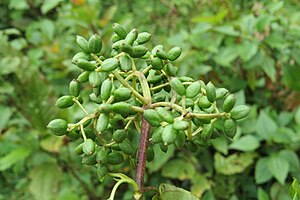Note: This is a project under development. The articles on this wiki are just being initiated and broadly incomplete. You can Help creating new pages.
Viburnum coriaceum
Viburnum cylindricum is an evergreen shrub or small tree; it usually grows up to 8 metres tall, exceptionally reaching 15 metres. In cultivation it is likely to be no more than 5 metres tall. The plant is sometimes harvested from the wild for local use as a food, medicine and source of materials. It is cultivated for medicinal use in the homegardens of southern Yunnan, can be used as a pioneer in reforestation and is sometimes grown as an ornamental.
Contents
- 1 Uses
- 2 Parts Used
- 3 Chemical Composition
- 4 Common names
- 5 Properties
- 6 Habit
- 7 Identification
- 8 List of Ayurvedic medicine in which the herb is used
- 9 Where to get the saplings
- 10 Mode of Propagation
- 11 How to plant/cultivate
- 12 Commonly seen growing in areas
- 13 Photo Gallery
- 14 References
- 15 External Links
Uses
Parts Used
Chemical Composition
It contains petroleum ether (60 – 80°C), chloroform and 75% aqueous ethanol etc.[2]
Common names
| Language | Common name |
|---|---|
| Kannada | |
| Hindi | Kala Titmalia |
| Malayalam | |
| Tamil | |
| Telugu | |
| Marathi | |
| Gujarathi | |
| Punjabi | |
| Kashmiri | |
| Sanskrit | Tilvaka bedha |
| English | Cylindrical Viburnum |
Properties
Reference: Dravya - Substance, Rasa - Taste, Guna - Qualities, Veerya - Potency, Vipaka - Post-digesion effect, Karma - Pharmacological activity, Prabhava - Therepeutics.
Dravya
Rasa
Guna
Veerya
Vipaka
Karma
Prabhava
Habit
Identification
Leaf
| Kind | Shape | Feature |
|---|---|---|
Flower
| Type | Size | Color and composition | Stamen | More information |
|---|---|---|---|---|
| {{{5}}} |
Fruit
| Type | Size | Mass | Appearance | Seeds | More information |
|---|---|---|---|---|---|
Other features
List of Ayurvedic medicine in which the herb is used
Where to get the saplings
Mode of Propagation
Seeds, Cuttings of soft-wood, Cuttings of mature wood, Cuttings of half-ripe wood.
How to plant/cultivate
Viburnum cylindricum has a range extending from the warm temperate regions of China and India (where it can be found at elevations up to 3,300 metres) to the tropical regions of Malaysia and Indonesia (usually at elevations in excess of 1,000 metres).[4]
Commonly seen growing in areas
Rather dry forests, Mainly with rhododendron, Sparse forests.
Photo Gallery
References
- ↑ Indian Medicinal Plants by C.P.Khare
- ↑ Chemical constituents
- ↑ [Morphology]
- ↑ Cultivation
External Links
- Ayurvedic Herbs known to be helpful to treat Itchy skin
- Herbs with Seeds used in medicine
- Herbs with common name in Hindi
- Herbs with common name in Sanskrit
- Herbs with common name in English
- Habit - Evergreen Shrub
- Index of Plants which can be propagated by Seeds
- Index of Plants which can be propagated by Cuttings of soft-wood
- Index of Plants which can be propagated by Cuttings of mature wood
- Index of Plants which can be propagated by Cuttings of half-ripe wood
- Herbs that are commonly seen in the region of Rather dry forests
- Herbs that are commonly seen in the region of Mainly with rhododendron
- Herbs that are commonly seen in the region of Sparse forests
- Herbs

